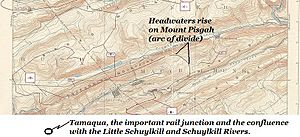Panther Creek Valley facts for kids

The Little Schuylkill River in eastern Pennsylvania was once very important. It helped move energy during the American Industrial Revolution, from the 1820s to the 1870s. This area stayed important for producing energy until the 1980s.
Panther Creek Valley is a special place. It sits between two long mountain ridges, Nesquehoning and Pisgah Ridge. These ridges held lots of Anthracite coal, which was like treasure. The coal from Panther Creek Valley made the region very rich. For many years, a company called the Lehigh Coal & Navigation Company (LC&N) controlled almost all the Anthracite coal that was shipped. This coal went to cities in the eastern U.S. through the Lehigh Canal and even to other countries.
Contents
The Rise of Coal Power
The Lehigh Coal & Navigation Company (LC&N) was like a high-tech company of its time. It was also a huge business that worked in many different areas. When people learned how to burn Anthracite coal cleanly, LC&N quickly used new technologies to get this fuel.
Why Coal Became So Important
After the American Revolution, cities and towns faced a big problem: they were running out of wood for fires. Wood was used for heating homes and for industries like iron foundries. This made wood and charcoal very expensive. People needed a new way to get heat and power.
In Europe, by the mid-1700s, people started using coal. They invented pumps to get coal out of mines and steam engines to help with work. Eventually, railroads were built to move coal. All these inventions helped people get the energy they needed.
America's Energy Challenge
The United States faced similar energy problems starting around 1800. Cities and new industries needed more fuel. This led to ideas like the American System. This plan aimed to improve transportation and help industries grow.
Local businesses and state governments worked together on these plans. States like Pennsylvania, New York, and Maryland created programs to build transportation routes. They wanted to reach new areas like the Ohio Country and Northwest Territories. Businesses hoped to sell goods to these new settlements.
Anthracite Coal: A New Discovery
Around the 1790s, people in the Philadelphia area discovered Anthracite coal nearby. They also learned how to light it and keep it burning. This was a big deal because Anthracite burned cleanly. This new fuel offered a solution to the growing energy crisis.
The idea of using Anthracite coal gained even more support after the 1824 presidential election. This period saw new economic ideas, sometimes called the American School, which focused on developing the nation's economy.

